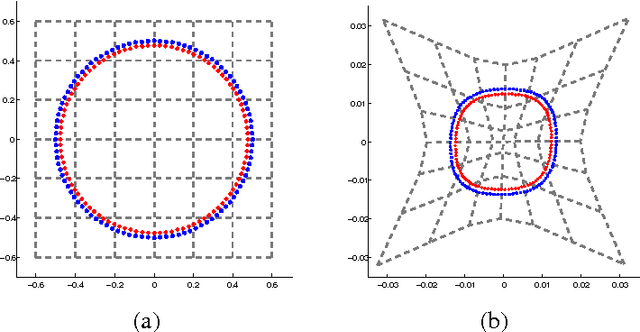Bibo Shi
Unsupervised Deformable Registration for Multi-Modal Images via Disentangled Representations
Mar 22, 2019



Abstract:We propose a fully unsupervised multi-modal deformable image registration method (UMDIR), which does not require any ground truth deformation fields or any aligned multi-modal image pairs during training. Multi-modal registration is a key problem in many medical image analysis applications. It is very challenging due to complicated and unknown relationships between different modalities. In this paper, we propose an unsupervised learning approach to reduce the multi-modal registration problem to a mono-modal one through image disentangling. In particular, we decompose images of both modalities into a common latent shape space and separate latent appearance spaces via an unsupervised multi-modal image-to-image translation approach. The proposed registration approach is then built on the factorized latent shape code, with the assumption that the intrinsic shape deformation existing in original image domain is preserved in this latent space. Specifically, two metrics have been proposed for training the proposed network: a latent similarity metric defined in the common shape space and a learningbased image similarity metric based on an adversarial loss. We examined different variations of our proposed approach and compared them with conventional state-of-the-art multi-modal registration methods. Results show that our proposed methods achieve competitive performance against other methods at substantially reduced computation time.
Nonlinear Metric Learning through Geodesic Interpolation within Lie Groups
May 16, 2018



Abstract:In this paper, we propose a nonlinear distance metric learning scheme based on the fusion of component linear metrics. Instead of merging displacements at each data point, our model calculates the velocities induced by the component transformations, via a geodesic interpolation on a Lie transfor- mation group. Such velocities are later summed up to produce a global transformation that is guaranteed to be diffeomorphic. Consequently, pair-wise distances computed this way conform to a smooth and spatially varying metric, which can greatly benefit k-NN classification. Experiments on synthetic and real datasets demonstrate the effectiveness of our model.
Nonlinear Metric Learning for kNN and SVMs through Geometric Transformations
Aug 06, 2015


Abstract:In recent years, research efforts to extend linear metric learning models to handle nonlinear structures have attracted great interests. In this paper, we propose a novel nonlinear solution through the utilization of deformable geometric models to learn spatially varying metrics, and apply the strategy to boost the performance of both kNN and SVM classifiers. Thin-plate splines (TPS) are chosen as the geometric model due to their remarkable versatility and representation power in accounting for high-order deformations. By transforming the input space through TPS, we can pull same-class neighbors closer while pushing different-class points farther away in kNN, as well as make the input data points more linearly separable in SVMs. Improvements in the performance of kNN classification are demonstrated through experiments on synthetic and real world datasets, with comparisons made with several state-of-the-art metric learning solutions. Our SVM-based models also achieve significant improvements over traditional linear and kernel SVMs with the same datasets.
 Add to Chrome
Add to Chrome Add to Firefox
Add to Firefox Add to Edge
Add to Edge